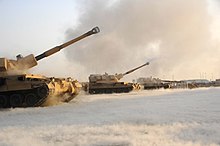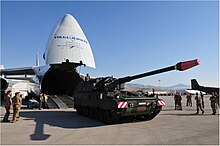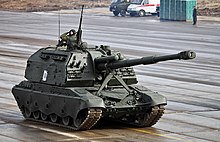
Back مدفعية ذاتية الحركة Arabic Özüyeriyən artilleriya Azerbaijani Самоходна артилерия Bulgarian Artilleria autopropulsada Catalan Panzerartillerie German Artillería autopropulsada Spanish Liikursuurtükk Estonian توپخانه خودکششی Persian Artillerie automotrice French Artileri swagerak ID
This article needs additional citations for verification. (January 2010) |



Self-propelled artillery (also called locomotive artillery) is artillery equipped with its own propulsion system to move toward its firing position. Within the terminology are the self-propelled gun, self-propelled howitzer, self-propelled mortar, and self-propelled rocket artillery. They are high-mobility vehicles, usually based on continuous tracks carrying either a large field gun, howitzer, mortar, or some form of rocket/missile launcher. They are usually used for long-range indirect bombardment support on the battlefield.
In the past, self-propelled artillery has included direct-fire vehicles, such as assault guns and tank destroyers, which were typically well-armoured vehicles often based upon the chassis of a tank. In lieu of the standard tank's general-purpose main gun that fired both high-explosive and anti-tank ammunition, direct-fire vehicles had specialized roles, with assault guns providing close fire-support for infantry and tank destroyers mounting an anti-tank gun to take on enemy armour.
Modern self-propelled artillery vehicles often mount their main gun in a turret on a tracked chassis so they superficially resemble tanks. However, they are generally lightly armoured, which is insufficient to withstand direct-fire combat; nonetheless this protects their crews against shrapnel and small arms and therefore they are usually included as armoured fighting vehicles. Many are equipped with machine guns for defense against enemy infantry.
The key advantage of self-propelled over towed artillery is that it can be brought into action much faster. Before the towed artillery can be used, it has to stop, unlimber and set up the guns. To move position, the guns must be limbered up again and brought—usually towed—to the new location. By comparison, self-propelled artillery can stop at a chosen location and begin firing almost immediately, then quickly move on to a new position. This shoot-and-scoot ability is very useful in a mobile conflict and particularly on the advance in open battlefields.[1]
Conversely, towed artillery was and remains cheaper to build and maintain. It is also lighter and can be deployed in areas that self-propelled guns cannot reach. Since the Vietnam War, heavy transport helicopters have also been used for rapid artillery deployment albeit at considerable expense and risk, mitigating one of towed artillery's disadvantages. Both self-propelled and towed artillery remain in the arsenals of many modern armies.[1]